MOF-Derived Cu@Cu2O Nanocatalyst for Oxygen Reduction Reaction and Cycloaddition Reaction
Abstract
:1. Introduction
2. Results and Discussion
2.1. Catalyst Characterization
2.2. Electrocatalytic Activity of Cu@Cu2O Core-Shell Nanocatalyst
2.3. Catalytic Activity of Cu@Cu2O Core-Shell Nanocatalyst in Azide-Alkyne Huisgen Cycloaddition
3. Materials and Methods
3.1. General Remarks
3.2. Synthesis of Cu3(BTC)2 MOF (Cu(II)-MOF) and Cu@Cu2O Core-Shell Nanocatalyst
3.3. Electrode Preparation and Electrochemical Measurements
3.4. General Procedure for Azide-Alkyne Huisgen Cycloadditions
4. Conclusions
Acknowledgments
Author Contributions
Conflicts of Interest
References
- Wang, H.; Zhu, Q.L.; Zou, R.; Xu, Q. Metal-organic frameworks for energy applications. Chem 2017, 2, 52–80. [Google Scholar] [CrossRef]
- Woo, H.; Kim, E.; Kim, J.H.; Yun, S.W.; Park, J.C.; Kim, Y.T.; Park, K.H. Shape and Composition Control of Monodisperse Hybrid Pt-CoO Nanocrystals by Controlling the Reaction Kinetics with Additives. Sci. Rep. 2017, 7, 3851. [Google Scholar] [CrossRef] [PubMed]
- Kim, A.; Shin, D.; Kim, M.; Yoon, C.; Song, H.; Park, K.H. Facile synthesis of multipodal MnO nanocrystals and their catalytic performance. Eur. J. Inorg. Chem. 2014, 8, 1279–1283. [Google Scholar] [CrossRef]
- Komathi, S.; Gopalan, A.I.; Muthuchamy, N.; Lee, K.P. Polyaniline nanoflowers grafted onto nanodiamonds via a soft template-guided secondary nucleation process for high-performance glucose sensing. RSC Adv. 2017, 7, 15342–15351. [Google Scholar] [CrossRef]
- Jang, S.; Sa, Y.J.; Joo, S.H.; Park, K.H. Ordered mesoporous copper oxide nanostructures as highly active and stable catalysts for aqueous click reactions. Catal. Commun. 2016, 81, 24–28. [Google Scholar] [CrossRef]
- Gopalan, A.I.; Muthuchamy, N.; Lee, K.P. A novel bismuth oxychloride-graphene hybrid nanosheets based non-enzymatic photoelectrochemical glucose sensing platform for high performances. Biosens. Bioelectron. 2017, 89, 352–360. [Google Scholar] [CrossRef] [PubMed]
- Deutsch, M.; Horvath, F.; Knoll, C.; Lager, D.; Gierl-Mayer, C.; Weinberger, P.; Winter, F. High-temperature energy storage: Kinetic investigations of the CuO/Cu2O reaction cycle. Energy Fuels 2017, 31, 2324–2334. [Google Scholar] [CrossRef]
- Park, H.J.; Choi, N.J.; Kang, H.; Jung, M.Y.; Park, J.W.; Park, K.H.; Lee, D.S. A ppb-level formaldehyde gas sensor based on CuO nanocubes prepared using a polyol process. Sens. Actuators B Chem. 2014, 203, 282–288. [Google Scholar] [CrossRef]
- Zhan, J.; Chen, M.; Xia, X. Controllable synthesis of copper oxide/carbon core/shell nanowire arrays and their application for electrochemical energy storage. Nanomaterials 2015, 5, 1610–1619. [Google Scholar] [CrossRef] [PubMed]
- Muthuchamy, N.; Gopalan, A.I.; Lee, K.P. New titanium dioxide-based heterojunction nanohybrid for highly selective photoelectrochemical–electrochemical dual-mode sensors. ACS Appl. Mater. Interfaces 2017, 9, 37166–37183. [Google Scholar]
- Zhou, L.; He, Y.; Jia, C.; Pavlinek, V.; Saha, P.; Cheng, Q. Construction of hierarchical CuO/Cu2O@NiCo2S4 nanowire arrays on copper foam for high performance supercapacitor electrodes. Nanomaterials 2017, 7, 273. [Google Scholar] [CrossRef] [PubMed]
- Li, X.; Li, X.; Chen, N.; Li, X.; Zhang, J.; Yu, J.; Wang, J.; Tang, Z. CuO-In2O3 core-shell nanowire based chemical gas sensors. J. Nanomater. 2014, 2014, 973156. [Google Scholar]
- Muthuchamy, N.; Lee, K.P.; Gopalan, A.I. Enhanced photoelectrochemical biosensing performances for graphene (2D)–Titanium dioxide nanowire (1D) heterojunction polymer conductive nanosponges. Biosens. Bioelectron. 2017, 89, 390–399. [Google Scholar] [CrossRef] [PubMed]
- Muthuchamy, N.; Gopalan, A.; Lee, K.P. A new facile strategy for higher loading of silver nanoparticles onto silica for efficient catalytic reduction of 4-nitrophenol. RSC Adv. 2015, 5, 76170–76181. [Google Scholar] [CrossRef]
- Ahamed, M.; Alhadlaq, H.A.; Khan, M.; Karuppiah, P.; Al-Dhabi, N.A. Synthesis, characterization, and antimicrobial activity of copper oxide nanoparticles. J. Nanomater. 2014, 2014, 637858. [Google Scholar] [CrossRef]
- Liu, B.; Zhang, X.; Shioyama, H.; Mukai, T.; Sakai, T.; Xu, Q. Converting cobalt oxide subunits in cobalt metal-organic framework into agglomerated Co3O4 nanoparticles as an electrode material for lithium ion battery. J. Power Sources 2010, 195, 857–861. [Google Scholar] [CrossRef]
- Muthuchamy, N.; Gopalan, A.I.; Lee, K.P. Highly selective non-enzymatic electrochemical sensor based on a titanium dioxide nanowire–poly(3-aminophenyl boronic acid)–gold nanoparticle ternary nanocomposite. RSC Adv. 2018, 8, 2138–2147. [Google Scholar] [CrossRef]
- Hsueh, Y.-H.; Tsai, P.-H.; Lin, K.-S. Ph-dependent antimicrobial properties of copper oxide nanoparticles in staphylococcus aureus. Int. J. Mol. Sci. 2017, 18, 793. [Google Scholar] [CrossRef] [PubMed]
- Konar, S.; Kalita, H.; Puvvada, N.; Tantubay, S.; Mahto, M.K.; Biswas, S.; Pathak, A. Shape-dependent catalytic activity of CuO nanostructures. J. Catal. 2016, 336, 11–22. [Google Scholar] [CrossRef]
- Caldas, P.C.; Gallo, J.M.R.; Lopez-Castillo, A.; Zanchet, D.; Correa Bueno, J.M. The structure of the Cu–CuO sites determines the catalytic activity of cu nanoparticles. ACS Catal. 2017, 7, 2419–2424. [Google Scholar] [CrossRef]
- Pan, K.; Ming, H.; Yu, H.; Liu, Y.; Kang, Z.; Zhang, H.; Lee, S.T. Different copper oxide nanostructures: Synthesis, characterization, and application for C-N cross-coupling catalysis. Cryst. Res. Technol. 2011, 46, 1167–1174. [Google Scholar] [CrossRef]
- Ranu, B.C.; Dey, R.; Chatterjee, T.; Ahammed, S. Copper nanoparticle-catalyzed carbon-carbon and carbon-heteroatom bond formation with a greener perspective. ChemSusChem 2012, 5, 22–44. [Google Scholar] [CrossRef] [PubMed]
- Amini, M.; Pourvahabi Anbari, A.; Ramezani, S.; Gautam, S.; Hwa Chae, K. Copper(II) oxide nanoparticles as an efficient catalyst in the azide–alkynecycloaddition. ChemistrySelect 2016, 1, 4607–4612. [Google Scholar] [CrossRef]
- Woo, H.; Kang, H.; Kim, A.; Jang, S.; Park, J.C.; Park, S.; Kim, B.-S.; Song, H.; Park, K.H. Azide-alkyne Huisgen [3 + 2] cycloaddition using CuO nanoparticles. Molecules 2012, 17, 13235–13252. [Google Scholar] [CrossRef] [PubMed] [Green Version]
- Kang, H.; Lee, H.J.; Park, J.C.; Song, H.; Park, K.H. Solvent-free microwave promoted [3 + 2] cycloaddition of alkyne-azide in uniform CuO hollow nanospheres. Top. Catal. 2010, 53, 523–528. [Google Scholar] [CrossRef]
- Kim, A.; Sharma, B.; Kim, B.-S.; Park, K.H. Double-hydrophilic block copolymer nanoreactor for the synthesis of copper nanoparticles and for application in click chemistry. J. Nanosci. Nanotechnol. 2011, 11, 6162–6166. [Google Scholar] [CrossRef] [PubMed]
- Jang, S.; Yoon, C.; Lee, J.M.; Park, S.; Park, K.H. Preparation of Cu@Cu2O nanocatalysts by reduction of HKUST-1 for oxidation reaction of catechol. Molecules 2016, 21, 1467. [Google Scholar] [CrossRef] [PubMed]
- Mu, H.; Li, C.; Bai, J. The composite catalysts of Cu/CuxO nanoparticles supported on the carbon fibers were prepared for styrene oxidation reaction. Appl. Organomet. Chem. 2017, 31, e3890. [Google Scholar] [CrossRef]
- Gonçalves, R.V.; Wojcieszak, R.; Wender, H.; Sato, B.; Dias, C.; Vono, L.L.; Eberhardt, D.; Teixeira, S.R.; Rossi, L.M. Easy access to metallic copper nanoparticles with high activity and stability for co oxidation. ACS Appl. Mater. Interfaces 2015, 7, 7987–7994. [Google Scholar] [CrossRef] [PubMed]
- Xu, L.; Srinivasakannan, C.; Peng, J.; Zhang, L.; Zhang, D. Synthesis of Cu-CuO nanocomposite in microreactor and its application to photocatalytic degradation. J. Alloys Compd. 2017, 695, 263–269. [Google Scholar] [CrossRef]
- Zhao, X.; Tan, Y.; Wu, F.; Niu, H.; Tang, Z.; Cai, Y.; Giesy, J.P. Cu/Cu2O/CuO loaded on the carbon layer derived from novel precursors with amazing catalytic performance. Sci. Total Environ. 2016, 571, 380–387. [Google Scholar] [CrossRef] [PubMed]
- Panda, N.; Jena, A.K.; Mohapatra, S.; Rout, S.R. Copper ferrite nanoparticle-mediated N-arylation of heterocycles: A ligand-free reaction. Tetrahedron Lett. 2011, 52, 1924–1927. [Google Scholar] [CrossRef]
- Yang, D.; Zhu, X.; Wei, W.; Sun, N.; Yuan, L.; Jiang, M.; You, J.; Wang, H. Magnetically recoverable and reusable CuFe2O4 nanoparticle-catalyzed synthesis of benzoxazoles, benzothiazoles and benzimidazoles using dioxygen as oxidant. RSC Adv. 2014, 4, 17832–17839. [Google Scholar] [CrossRef]
- Kirillova, M.V.; Santos, C.I.; Wu, W.; Tang, Y.; Kirillov, A.M. Mild oxidative C−H functionalization of alkanes and alcohols using a magnetic core-shell Fe3O4@2@Cu4 nanocatalyst. J. Mol. Catal. A Chem. 2017, 426, 343–349. [Google Scholar] [CrossRef]
- Yang, W.; Salim, J.; Ma, C.; Ma, Z.; Sun, C.; Li, J.; Chen, L.; Kim, Y. Flowerlike Co3O4 microspheres loaded with copper nanoparticle as an efficient bifunctional catalyst for lithium–air batteries. Electrochem. Commun. 2013, 28, 13–16. [Google Scholar] [CrossRef]
- Kaur, R.; Pal, B. Cu nanostructures of various shapes and sizes as superior catalysts for nitro-aromatic reduction and co-catalyst for Cu/TiO2 photocatalysis. Appl. Catal. A Gen. 2015, 491, 28–36. [Google Scholar] [CrossRef]
- Gopalan, A.I.; Muthuchamy, N.; Komathi, S.; Lee, K.P. A novel multicomponent redox polymer nanobead based high performance non-enzymatic glucose sensor. Biosens. Bioelectron. 2016, 84, 53–63. [Google Scholar] [CrossRef] [PubMed]
- Dong, Q.; Zhao, Y.; Han, X.; Wang, Y.; Liu, M.; Li, Y. Pd/Cu bimetallic nanoparticles supported on graphene nanosheets: Facile synthesis and application as novel electrocatalyst for ethanol oxidation in alkaline media. Int. J. Hydrog. Energy 2014, 39, 14669–14679. [Google Scholar] [CrossRef]
- Jin, X.; Dang, L.; Lohrman, J.; Subramaniam, B.; Ren, S.; Chaudhari, R.V. Lattice-matched bimetallic CuPd-graphene nanocatalysts for facile conversion of biomass-derived polyols to chemicals. ACS Nano 2013, 7, 1309–1316. [Google Scholar] [CrossRef] [PubMed]
- Liu, Y.; Tang, Z. Multifunctional nanoparticle@MOF core–shell nanostructures. Adv. Mater. 2013, 25, 5819–5825. [Google Scholar] [CrossRef] [PubMed]
- Dang, S.; Zhu, Q.L.; Xu, Q. Nanomaterials derived from metal–organic frameworks. Nat. Rev. Mater. 2017, 3, 17075. [Google Scholar] [CrossRef]
- Yang, J.-M.; Liu, Q.; Sun, W.-Y. Co(II)-doped MOF-5 nano/microcrystals: Solvatochromic behaviour, sensing solvent molecules and gas sorption property. J. Solid State Chem. 2014, 218, 50–55. [Google Scholar] [CrossRef]
- Wan, M.; Zhang, X.; Li, M.; Chen, B.; Yin, J.; Jin, H.; Lin, L.; Chen, C.; Zhang, N. Hollow Pd/MOF nanosphere with double shells as multifunctional catalyst for hydrogenation reaction. Small 2017, 13, 1701395. [Google Scholar] [CrossRef] [PubMed]
- Sava Gallis, D.F.; Rohwer, L.E.; Rodriguez, M.A.; Barnhart-Dailey, M.C.; Butler, K.S.; Luk, T.S.; Timlin, J.A.; Chapman, K.W. Multifunctional, tunable metal–organic framework materials platform for bioimaging applications. ACS Appl. Mater. Interfaces 2017, 9, 22268–22277. [Google Scholar] [CrossRef] [PubMed]
- Wang, X.; Zhou, J.; Fu, H.; Li, W.; Fan, X.; Xin, G.; Zheng, J.; Li, X. MOF derived catalysts for electrochemical oxygen reduction. J. Mater. Chem. A 2014, 2, 14064–14070. [Google Scholar] [CrossRef]
- Ma, D.; Li, B.; Liu, K.; Zhang, X.; Zou, W.; Yang, Y.; Li, G.; Shi, Z.; Feng, S. Bifunctional MOF heterogeneous catalysts based on the synergy of dual functional sites for efficient conversion of CO2 under mild and co-catalyst free conditions. J. Mater. Chem. A 2015, 3, 23136–23142. [Google Scholar] [CrossRef]
- Wang, T.; Zhou, Q.; Wang, X.; Zheng, J.; Li, X. MOF-derived surface modified Ni nanoparticles as an efficient catalyst for the hydrogen evolution reaction. J. Mater. Chem. A 2015, 3, 16435–16439. [Google Scholar] [CrossRef]
- Meng, F.; Fang, Z.; Li, Z.; Xu, W.; Wang, M.; Liu, Y.; Zhang, J.; Wang, W.; Zhao, D.; Guo, X. Porous Co3O4 materials prepared by solid-state thermolysis of a novel Co-MOF crystal and their superior energy storage performances for supercapacitors. J. Mater. Chem. A 2013, 1, 7235–7241. [Google Scholar] [CrossRef]
- Bai, C.; Li, A.; Yao, X.; Liu, H.; Li, Y. Efficient and selective aerobic oxidation of alcohols catalysed by MOF-derived Co catalysts. Green Chem. 2016, 18, 1061–1069. [Google Scholar] [CrossRef]
- Liu, J.; Wu, C.; Xiao, D.; Kopold, P.; Gu, L.; van Aken, P.A.; Maier, J.; Yu, Y. MOF-derived gollow Co9S8 nanoparticles embedded in graphitic carbon nanocages with superior Li-ion storage. Small 2016, 12, 2354–2364. [Google Scholar] [CrossRef] [PubMed]
- Liu, H.; Zhang, S.; Liu, Y.; Yang, Z.; Feng, X.; Lu, X.; Huo, F. Well-dispersed and size-controlled supported metal oxide nanoparticles derived from MOF composites and further application in catalysis. Small 2015, 11, 3130–3134. [Google Scholar] [CrossRef] [PubMed]
- Lü, Y.; Zhan, W.; He, Y.; Wang, Y.; Kong, X.; Kuang, Q.; Xie, Z.; Zheng, L. MOF-templated synthesis of porous Co3O4 concave nanocubes with high specific surface area and their gas sensing properties. ACS Appl. Mater. Interfaces 2014, 6, 4186–4195. [Google Scholar] [CrossRef] [PubMed]
- Kundu, T.; Sahoo, S.C.; Banerjee, R. Solid-state thermolysis of anion induced metal–organic frameworks to ZnO microparticles with predefined morphologies: Facile synthesis and solar cell studies. Cryst. Growth Des. 2012, 12, 2572–2578. [Google Scholar] [CrossRef]
- Wang, Y.; Sang, S.; Zhu, W.; Gao, L.; Xiao, G. CuNi@C catalysts with high activity derived from metal–organic frameworks precursor for conversion of furfural to cyclopentanone. Chem. Eng. J. 2016, 299, 104–111. [Google Scholar] [CrossRef]
- Rowsell, J.L.; Yaghi, O.M. Effects of functionalization, catenation, and variation of the metal oxide and organic linking units on the low-pressure hydrogen adsorption properties of metal−organic frameworks. J. Am. Chem. Soc. 2006, 128, 1304–1315. [Google Scholar] [CrossRef] [PubMed]
- Okada, K.; Ricco, R.; Tokudome, Y.; Styles, M.J.; Hill, A.J.; Takahashi, M.; Falcaro, P. Copper conversion into Cu(OH)2 nanotubes for positioning Cu3(BTC)2 MOF crystals: Controlling the growth on flat plates, 3d architectures, and as patterns. Adv. Funct. Mater. 2014, 24, 1969–1977. [Google Scholar] [CrossRef]
- Xiang, Z.; Cao, D.; Shao, X.; Wang, W.; Zhang, J.; Wu, W. Facile preparation of high-capacity hydrogen storage metal-organic frameworks: A combination of microwave-assisted solvothermal synthesis and supercritical activation. Chem. Eng. Sci. 2010, 65, 3140–3146. [Google Scholar] [CrossRef]
- Petit, C.; Burress, J.; Bandosz, T.J. The synthesis and characterization of copper-based metal–organic framework/graphite oxide composites. Carbon 2011, 49, 563–572. [Google Scholar] [CrossRef]
- Song, M.J.; Kim, I.T.; Kim, Y.B.; Kim, J.; Shin, M.W. Metal–organic frameworks-derived porous carbon/Co3O4 composites for rechargeable lithium–oxygen batteries. Electrochimica Acta 2017, 230, 73–80. [Google Scholar] [CrossRef]
- Chen, B.; Ma, G.; Zhu, Y.; Xia, Y. Metal-organic-frameworks derived cobalt embedded in various carbon structures as bifunctional electrocatalysts for oxygen reduction and evolution reactions. Sci. Rep. 2017, 7, 5266. [Google Scholar] [CrossRef] [PubMed]
- Deo, M.; Mujawar, S.; Game, O.; Yengantiwar, A.; Banpurkar, A.; Kulkarni, S.; Jog, J.; Ogale, S. Strong photo-response in a flip-chip nanowire p-Cu2O/n-ZnO junction. Nanoscale 2011, 3, 4706–4712. [Google Scholar] [CrossRef] [PubMed]
- Poulston, S.; Parlett, P.; Stone, P.; Bowker, M. Surface oxidation and reduction of CuO and Cu2O studied using XPS and XAES. Surf. Interface Anal. 1996, 24, 811–820. [Google Scholar] [CrossRef]
- Xi, Y.-T.; Wei, P.-J.; Wang, R.-C.; Liu, J.-G. Bio-inspired multinuclear copper complexes covalently immobilized on reduced graphene oxide as efficient electrocatalysts for the oxygen reduction reaction. Chem. Commun. 2015, 51, 7455–7458. [Google Scholar] [CrossRef] [PubMed]
- He, Q.; Yang, X.; He, R.; Bueno-López, A.; Miller, H.; Ren, X.; Yang, W.; Koel, B.E. Electrochemical and spectroscopic study of novel Cu and Fe-based catalysts for oxygen reduction in alkaline media. J. Power Sources 2012, 213, 169–179. [Google Scholar] [CrossRef]
- Zhang, X.; Zhang, Y.; Huang, H.; Cai, J.; Ding, K.; Lin, S. Electrochemical fabrication of shape-controlled Cu2O with spheres, octahedrons and truncated octahedrons and their electrocatalysis for ORR. New J. Chem. 2018, 42, 458–464. [Google Scholar] [CrossRef]
- Sharpless, K.B.; Manetsch, R. In situ click chemistry: A powerful means for lead discovery. Expert Opin. Drug Discov. 2006, 1, 525–538. [Google Scholar] [CrossRef] [PubMed]
- Moses, J.E.; Moorhouse, A.D. The growing applications of click chemistry. Chem. Soc. Rev. 2007, 36, 1249–1262. [Google Scholar] [CrossRef] [PubMed]
- Agalave, S.G.; Maujan, S.R.; Pore, V.S. Click chemistry: 1,2,3-triazoles as pharmacophores. Chemistry 2011, 6, 2696–2718. [Google Scholar] [CrossRef] [PubMed]
- Zheng, T.; Rouhanifard, S.H.; Jalloh, A.S.; Wu, P. Click triazoles for bioconjugation. In Click Triazoles; Springer: Berlin, Germany, 2012; pp. 163–183. [Google Scholar]
- Breinbauer, R.; Köhn, M. Azide–alkyne coupling: A powerful reaction for bioconjugate chemistry. ChemBioChem 2003, 4, 1147–1149. [Google Scholar] [CrossRef] [PubMed]
- Xi, W.; Scott, T.F.; Kloxin, C.J.; Bowman, C.N. Click chemistry in materials science. Adv. Funct. Mater. 2014, 24, 2572–2590. [Google Scholar] [CrossRef]
- Amini, M.; Naslhajian, H.; Farnia, S.M.F.; Kang, H.K.; Gautam, S.; Chae, K.H. Polyoxomolybdate-stabilized Cu2O nanoparticles as an efficient catalyst for the azide–alkyne cycloaddition. New J. Chem. 2016, 40, 5313–5317. [Google Scholar] [CrossRef]
- Faraji, M.; Amini, M.; Anbari, A.P. Preparation and characterization of TiO2-nanotube/Ti plates loaded Cu2O nanoparticles as a novel heterogeneous catalyst for the azide–alkyne cycloaddition. Catal. Commun. 2016, 76, 72–75. [Google Scholar] [CrossRef]
- Kimber, R.L.; Lewis, E.A.; Parmeggiani, F.; Smith, K.; Bagshaw, H.; Starborg, T.; Joshi, N.; Figueroa, A.I.; van der Laan, G.; Cibin, G.; et al. Biosynthesis and characterization of copper nanoparticles using Shewanella oneidensis: Application for click chemistry. Small 2018. [Google Scholar] [CrossRef] [PubMed]
- Ghosh, S.; Saha, S.; Sengupta, D.; Chattopadhyay, S.; De, G.; Basu, B. Stabilized Cu2O nanoparticles on macroporous polystyrene resins [Cu2O@ARF]: Improved and reusable heterogeneous catalyst for on-water synthesis of triazoles via click reaction. Ind. Eng. Chem. Res. 2017, 56, 11726–11733. [Google Scholar] [CrossRef]
- Shaabani, S.; Tavousi Tabatabaei, A.; Shaabani, A. Copper(I) oxide nanoparticles supported on magnetic casein as a bio-supported and magnetically recoverable catalyst for aqueous click chemistry synthesis of 1,4-disubstituted 1,2,3-triazoles. Appl. Organomet. Chem. 2017, 31, e3559. [Google Scholar] [CrossRef]
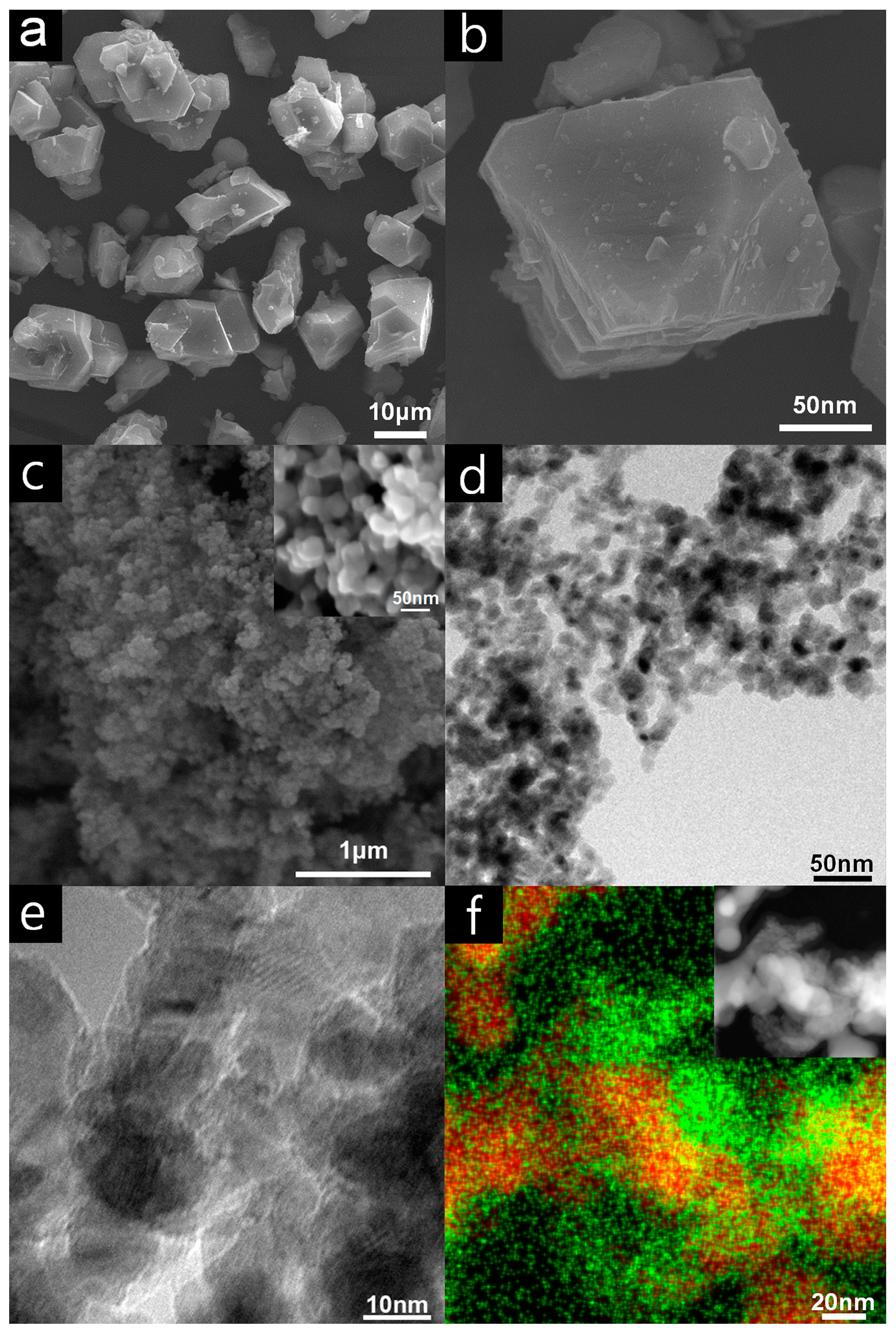
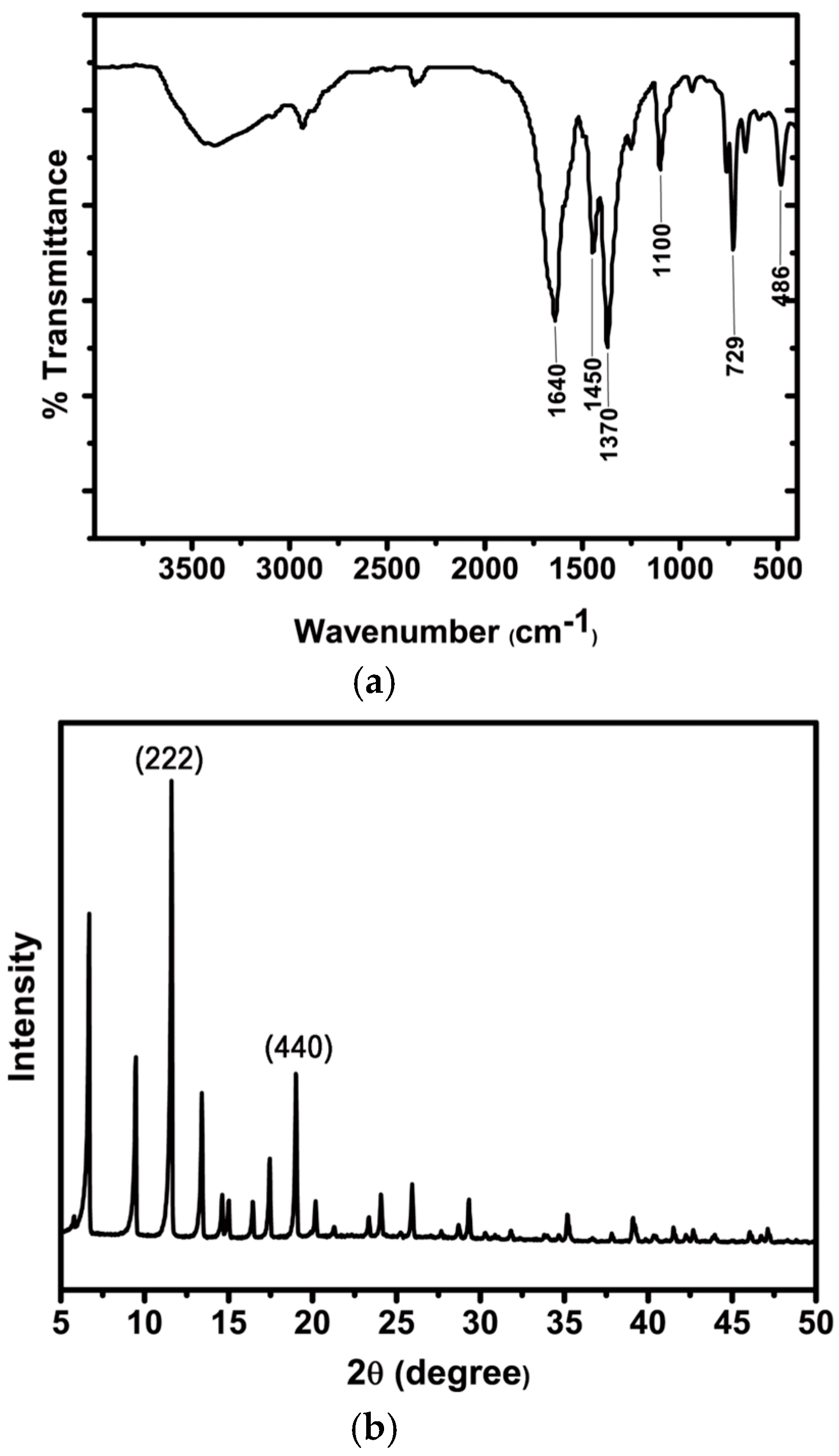
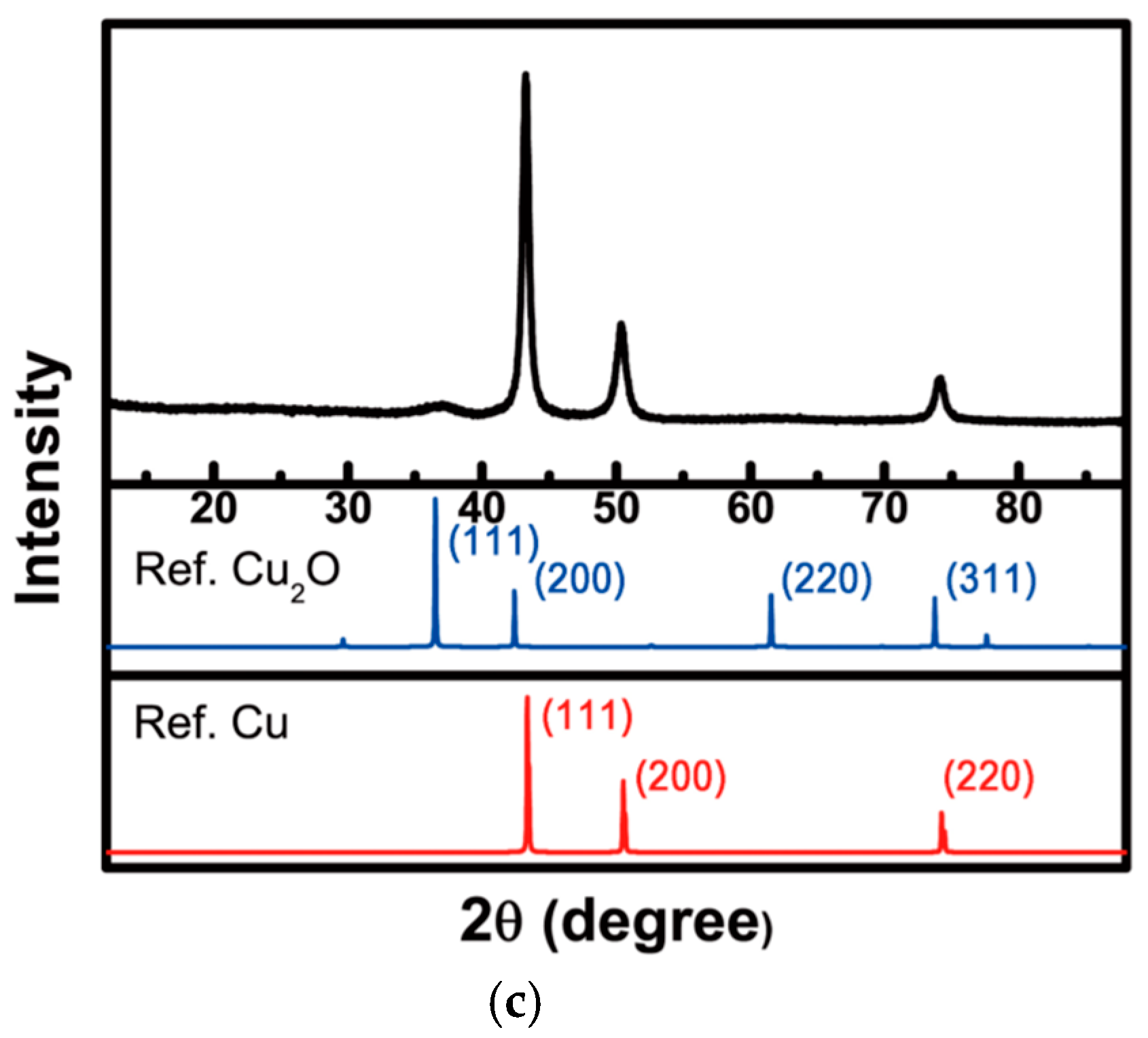
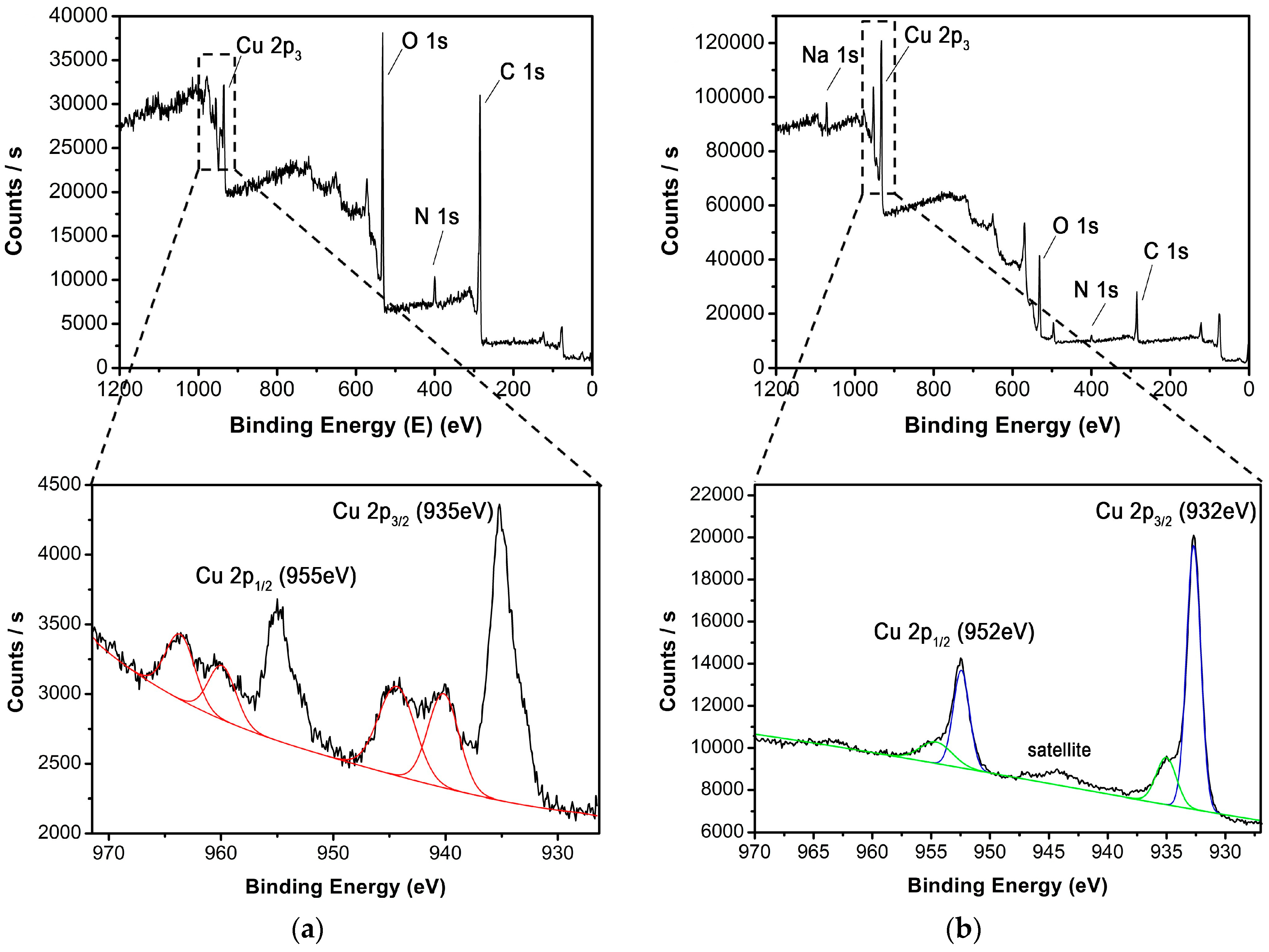

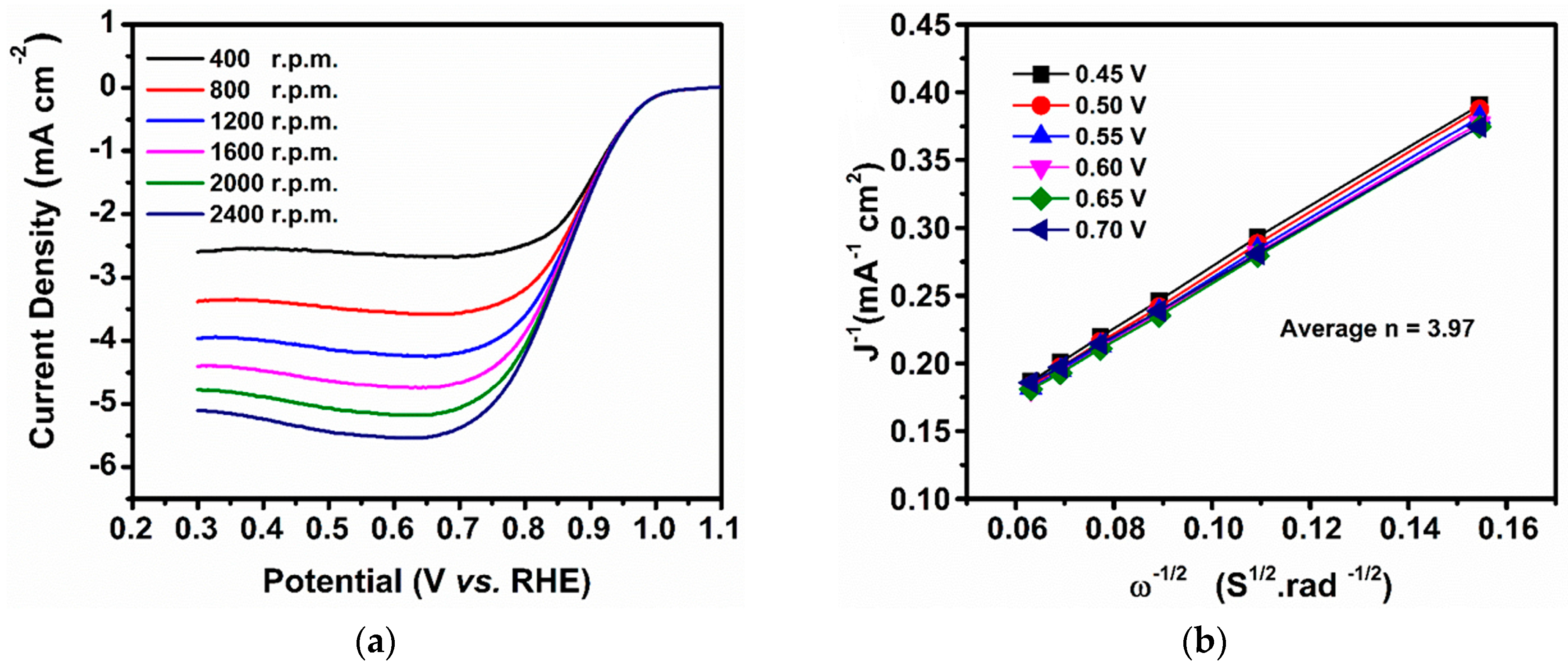
 | ||
 1a, 100% |  1b, 95% |  1c, 80% |
 1d, 100% |  1e, 100% |  1f, 64% |
 1g, 69% |  1h, 83% |  1i, 97% |
 1j, 99% |  1k, 87% |  1l, 100% |
© 2018 by the authors. Licensee MDPI, Basel, Switzerland. This article is an open access article distributed under the terms and conditions of the Creative Commons Attribution (CC BY) license (http://creativecommons.org/licenses/by/4.0/).
Share and Cite
Kim, A.; Muthuchamy, N.; Yoon, C.; Joo, S.H.; Park, K.H. MOF-Derived Cu@Cu2O Nanocatalyst for Oxygen Reduction Reaction and Cycloaddition Reaction. Nanomaterials 2018, 8, 138. https://doi.org/10.3390/nano8030138
Kim A, Muthuchamy N, Yoon C, Joo SH, Park KH. MOF-Derived Cu@Cu2O Nanocatalyst for Oxygen Reduction Reaction and Cycloaddition Reaction. Nanomaterials. 2018; 8(3):138. https://doi.org/10.3390/nano8030138
Chicago/Turabian StyleKim, Aram, Nallal Muthuchamy, Chohye Yoon, Sang Hoon Joo, and Kang Hyun Park. 2018. "MOF-Derived Cu@Cu2O Nanocatalyst for Oxygen Reduction Reaction and Cycloaddition Reaction" Nanomaterials 8, no. 3: 138. https://doi.org/10.3390/nano8030138







